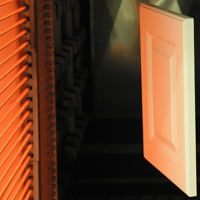
Infrared curing technology applies radiant energy to the part surface by direct transmission from an emitter. Infrared heats what needs to be heated, not the surrounding air, taking less time and energy to do the job. Infrared can cure a variety of finishing applications, from oddly shaped objects to demanding substrates and difficult coatings, for liquid or powder.
Electric infrared oven provides modular design, has been engineered for use with all coating types and can be configured to meet all parts sizes and shapes. It’s available in a full range of efficient wave length control for rapid, uniform heat up and accurate input temperature control. Either for preheat or flash off in painting line system, it’s particularly effective where increased line speeds and multiple control zones are required to achieve productivity objectives.
Comparing to traditional thermal based drying device, infrared curing provides compact, modular designs allow for configuration flexibility, while the emitters deliver efficient, clean heat energy for any applicationoffers higher production rates, lower operating costs and a high quality finish with minimal floor space.
Depending upon cure time desired, there’re three types of curing solutions – short wave with T3 tungsten filaments, medium wave with nickel chromium coil tubular element or ceramic long wave capabilities. Offering a variety of emitter wattages, heater sizes and voltages. The potential of a product to become heated with infrared depends on the following:
- Watt density (total output power)of the source
- Wavelength (temperature) of the source
- Distance from the source to the product
- Reflective characteristics of the oven cavity
- Air movement and temperature in the oven
- Time product is exposed to the source
- Ratio of exposed surface area to the mass of the product
- Specific heat of the product
- Emissivity of the product
- Thermal conductivity of the product
Short Wavelength – T3 Emitter
For pinpoint accuracy, rapid heat-up and instantaneous cool down and infinitely adjustable power, short wavelength IR is your solution. Utilizing a short wave T3 tungsten filament, sealed in a quartz envelope of halogen gas, the thin filament, being of little mass, is very reactive to the voltage applied to it. The infrared heat output reacts immediately to changes in applied voltage and provides rapid response time. Offering a long life of over 5,000 hours, when used at full voltage, you can count on a quality finish, time after time.
Medium Wavelength – Tubular Element Emitter
A reliable nickel chromium resistance coil is housed in a quartz tube providing a non-vertical burn design. Providing even heat patterning, produced through the tubular shaped emitters, and dual reflector system, make the heater popular for heat sensitive substrates such as plastic components and wood products. Most effective in applications requiring surface temperatures on the 120° F to 325°F(49° to 163° C) range.
Medium Wavelength – Coil Emitter
Unique sheathed tubular element, with nickel chromium resistance coil, packed in magnesium oxide, is engineered to ensure consistent temperatures and optimum radiant heat transfer efficiencies. Ideal for applications with complex geometric part profiles and temperature requirements of 250° F to 450° F (121° to 232° C), Versatile yet affordable.
Long Wavelength – Cone Emitter
Utilizes a high-grade chromium wire, that is helically wrapped around a ceramic cone-shaped core, and encased in a high-mass, hardened slurry, creating a durable, efficient long wave emitter. The ceramic cone’s modular and sturdy design allows the heater to be configured into virtually any pattern. The even heating pattern produced by the con-shaped emitter, and parabolic reflector, makes this heater most popular for heat sensitive substrates such as wood and plastic. The perfect choice for applications requiring temperatures of 300°F (149° C) and below.




